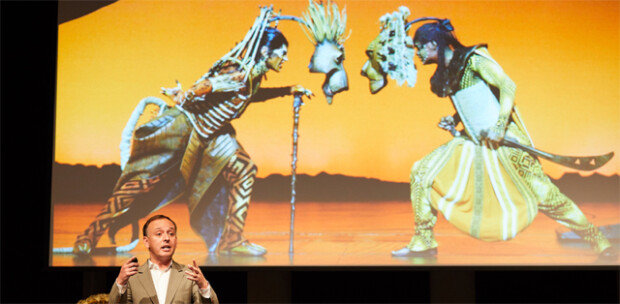Musical ‘Lion King’ holds press conference in Seoul
Musical ‘Lion King’ holds press conference in Seoul
Posted July. 31, 2018 08:02,
Updated July. 31, 2018 08:02

The blockbuster musical “Lion King” was unveiled in Seoul Monday through a press conference, which was short in duration but fairly impressive. Prior to an international tour in Korea, which is scheduled to kick off in Daegu in November, actors demonstrated some of the iconic numbers of the show in original form. At the press conference, Felipe Gamba, director of international strategy for the Disney theatrical group, and actress Ntsepa Pitjeng, who performs the role of “Rafiki,” revealed their expectations for meeting with Korean audiences.
As the Lion King International Tour in Korea will bring the original version of the musical, original stage settings as well as attire and props will serve as a great delight to the eyes of an audience. “Attire and props such as heavy corsets and masks that we wear on stage make the show more special and beautiful,” said Pitjeng. As the musical is set in the region of Africa, actors’ voice and tones sound exotic and the traditional musical instruments of African countries, Brazil, and Cuba also add to the exquisite harmony. One of the highlights of the show is a scene where a herd of wildebeest dashes across a valley, which is vividly presented to an audience thanks to the given perspective.
Arguably one of the most popular blockbuster musicals in the world, “Lion King” has been performed in more than 100 cities in some 20 countries, and seen by over 90 million people. A local production of the show was in fact performed at Charlotte Theater in Korea back in 2006. The Korean version, brought to the stage through a Japanese production company, however, ended in failure despite the injection of a huge production cost. Critics said that the local production failed to reproduce the original work in many aspects including the use of recorded music instead of live performances. Insiders even said that Korea was the “only country in the world where “Lion King” failed.” Gamba explained that the failure was due to “the Japanese production company’s lack of readiness and understanding about the Korean market.”
“Under the collaboration of some 100 foreign professionals, original equipment and props have all been brought along. We have put great efforts that it may take to move a city,” said Gamba. “We are aware that the Korean audience has higher standards than before, and will do our best to make the show fascinating enough for them.”
teller@donga.com






